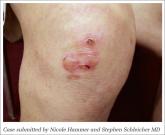Article

Diagnosis at a Glance
- Author:
- Roodabeh Samimi, DPM
- Stephen Schleicher, MD
- Nicole Hammer
A 56-year-old woman presents to the urgent care center with an ovoidshaped lump on the medial band of the plantar fascia; a 77-year-old man...
Article
Rash on a Man's Hand; Itchy Lower-Body Lesions on a Woman
- Author:
- Roodabeh Samimi, DPM
- Stephen M. Schleicher, MD
- A.J. Himmelsbach, NP
A 34-year-old man requests evaluation of a rash affecting his dorsal proximal right thumb and right wrist. A 35-year-old woman presents for...
Article
A Plantar Bullous Lesion, and a Case of Extranumerary Digits
- Author:
- Stephen M. Schleicher, MD
- Roodabeh Samimi, DPM
What treatment recommendations can you offer for each patient?
Article
An Erythematous Plaque With a Clear Center, and a Case of Back Excoriations
- Author:
- Stephen M. Schleicher, MD
- A.J. Himmelsbach, NP
- Roodabeh Samimi, DPM
Can you find the underlying cause for each of these conditions?
Article
Foot Problems in Two Patients
- Author:
- Stephen M. Schleicher, MD
- Katie Sopp, PA
- Roodabeh Samimi, DPM
A 23-year-old has eruptions on the soles of her feet and hands. An elderly man has a painful growth beneath his fifth toe. What is the diagnosis...
